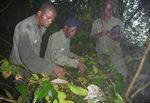Great Big Rhino and Gorilla Owners' Project Update 2018
←
→
Page content transcription
If your browser does not render page correctly, please read the page content below
Great Big Rhino and Gorilla Owners’
Project Update 2018
A message from Simon Tonge
Is there a more complicated issue in the that gorilla populations are slowly being
conservation world than rhinos? Maybe; cut off from each other, and each of these
but I really can’t think what it is. Despite the fragmented populations may simply be too
efforts of many people over many years, small to sustain a population of gorillas
the demand for rhino horn in Asia has not into perpetuity. The Cross River gorillas,
declined and the risks to the populations of in Nigeria, to which we provided support
wild rhinos in Africa and Asia are as great as in 2015, is a classic case in point, where
ever. However, before compassion fatigue our contribution was directed towards
sets in we should acknowledge that there maintaining a wildlife corridor between two
have been recent successes in the fight to core habitats. More such support is likely to
save these extraordinary creatures. Poaching be needed in the future.
levels in South Africa have levelled off, albeit
they are still too high: massive jail sentences Hopefully this little newsletter will give you
and fines have been levied on the poachers some insight that the help you have given is
and the criminal gangs that control them: making a difference, and you should
and no Javan rhino has been poached for be proud.
nearly 20 years. The challenge now, is
whether we can take those stabilisations
and turn them into an upward trend. There
is plenty of room in the world for more
rhinos; the challenge is to get them into the Simon Tonge
right areas and then provide the security Executive Director,
they need to do what comes naturally. Whitley Wildlife Conservation Trust
In some ways, gorillas provide us with
an equally perplexing challenge. They
are affected by poaching, but not on an
industrial scale like rhinos. It’s much more
likely to occur as local conflict with people
over access to land. No, the real problem is
that gorilla habitat is slowly and inexorably
being turned into farmland, and even the
reserves and parks set aside for them are
being encroached upon. The result isDWT also organises and supports the
annual rhino management operations in the
Matopos National Park. In 2017 six rhinos
were aneasthetised, all were dehorned to
deter poachers and four were ear-notched
to allow identification and monitoring. Two
animals also required the removal of snares
Rhino conservation through the but luckily had sustained no serious damage.
Dambari Wildlife Trust, Zimbabwe As part of the National Rhino Policy and
Management Framework operations for
Part of the money raised from The Great Big 2018 may include the first translocation of
Rhino Project was used to support the rhino white rhino into the Matopos National Park
conservation work of our long term partner since 1986 to bolster genetic diversity.
the Dambari Wildlife Trust (DWT) in
western Zimbabwe. Poaching data shows that rhino populations
in the Matopos are the safest in Zimbabwe
DWT uses our funding to support the which we believe is at least partly due to the
rangers of the Matopos National Park to support the rangers in this park receive from
manage their populations of black and DWT and it is vital we continue to help with
white rhinos in several ways. One of the this work.
most exciting is by monitoring the rhinos
using a network of camera traps. Rhinos
are regularly photographed by the traps
and can be recognised by their unique ear
notch markings providing huge amounts
of information on individuals and their
movements to the rangers.
Cross River Gorillas, Nigeria
In 2014, The Great Gorillas Project donated
£28,000 to the Wildlife Conservation
Society’s Nigeria Program (WCS) for the
conservation of the Cross River gorilla.
We chose to support this most critically
endangered of gorilla subspecies as we have
a long history of undertaking conservation
in Nigeria.
In 2017 the traps picked up a baby black The Cross River runs along the southern
rhino that the rangers were unaware of border between Nigeria and Cameroon and
which was brilliant news. Unfortunately, its surrounding forests are home to the last
towards the end of the year three of the 300 Cross River gorillas. One of the most
cameras were stolen. They would be worth important areas is the Mbe Mountains,
very little to anyone else so the worry is that a community-owned wildlife sanctuary
they are being stolen for the information that has around 30 gorillas and forms a
they contain, especially as there was an link between the two nature reserves that
increase in snares found at the same time in protect the rest of Nigeria’s gorillas.
those areas.The sanctuary is managed by the intervening villages. Instead of killing or
Conservation Association of the Mbe harassing the gorilla, the villagers reported
Mountains (CAMM) with support from his presence to WCS and helped monitor
WCS. Since CAMM was established, there his movements until he returned to the
has been no further poaching of gorillas in forest. The fact that a gorilla was brave
the area thanks to the patrols undertaken by enough to leave the sanctuary and the local
eco-guards who are employed from each of communities were not hostile is a strong
the nine communities that own the forest. indicator that the conservation projects
supported by our campaign are being
successful.
Silverback gorilla
Eco-guards inspect giorilla nest
The money raised by The Great Gorillas
Project was used to help fund these patrols
(salaries, rations and equipment) and run
conservation clubs for children in the
local villages. Additionally, it funded the
permanent demarcation of the community
reserve boundary and construction of a
central office for CAMM.
Whitley Wildlife Conservation Trust, Paignton Zoo, Living
Coasts and Newquay Zoo are education, scientific and
conservation charities dedicated to protecting our
global wildlife heritage.
CRG Conservation Club
Registered charity numbers:
Whitley Wildlife Conservation Trust – 30662
An incident in late 2017 highlights the Paignton Zoo and Newquay Zoo – 300923
positive effects of community engagement Living Coasts – 109976
for conservation. A young male gorilla left
the Afi Mountain Wildlife Sanctuary, which
neighbours Mbe, and took up residence
several kilometres away near to twoHelping protect Javan rhinos with the
Great Big Rhino Project
are comparable in size to the black rhino,
though only a few animals have actually
been weighed. They typically weigh between
900 and 2,300 kg. Javan rhinos are usually
solitary, except for females with small calves,
or during courtship. Occasionally young
animals may form pairs or small groups for
some time. Javan rhinos spend up a large part
of the day wallowing in mud holes. You can
watch a rare footage of a Javan rhino filmed
on a camera trap at the Ujung Kulon National
Park (credit: International Rhino Foundation).
The Great Big Rhino Project was a huge
success, raising £30,000 for Save the Rhino
International to protect critically endangered
Sumatran and Javan rhinos thanks to the
generosity of the Rhino Club bidders. 100%
of the fundraising donated to Save the Rhino
International was restricted to two essential
programmes: the Sumatran Rhino Sanctuary
and the Javan Rhino Study and Conservation
Area, with Save the Rhino International’s
programme partners Indonesian Rhino
Conservation Programme (YABI) and the Javan rhinos at risk
International Rhino Foundation (IRF). Your
With such low numbers concentrated in
support is helping with the expansion of the
one area, Javan rhinos are at risk to the
Sumatran Rhino Sanctuary to double its
effects of a natural disaster, such as volcanic
holding space, and activities to tackle invasive
eruptions from the nearby active volcano
plant species that are affecting the food
Anak Krakatau or the possibility of a resulting
availability and the habitat for Javan rhinos
tsunami, or the spread of disease. Although
in Indonesia.
the population is believed to be stable, it
likely has reached its carrying capacity in
Protecting Javan rhinos the current habitat and considered not to
Javan rhinos are considered to be one of be able to grow without intervention. It
the rarest large mammals in the world. was recognised that a second viable Javan
There are an estimated 61 - 63 Javan rhinos rhino population would be needed to be
left in a single population in Ujung Kulon established in another area of Indonesia. The
National Park in Indonesia. Javan rhinos population in Indonesia would need to growto create the 4,000 hectare Javan Rhino The Arenga palm is fast-growing and can
Study and Conservation Area (JRSCA), as dominate the lowland forest canopy and limit
a first stage towards developing a second plant growth along the forest floor.
habitat for a Javan Rhino population. The
JRSCA was set up to help understand
Javan rhinos and consider the safest ways
to manage and translocate Javan rhinos.
Alongside the JRSCA, Javan rhinos are
monitored and protected by the UKNP Park
Authority, WWF Indonesia, and Yayasan
Badak Indonesia (YABI). There have been no
recorded poaching instances of Javan rhinos
since 1999.
Your support to help tackle
tackle invasive plant species
This year the funds generously received from
The Javan rhino’s diet is characterised by Paignton Zoo and other donors are being
high species diversity. Hundreds of food plant used to help YABI to clear the Javan Rhino
species have been recorded, but about 40% Study and Conservation Area of the invasive
of the quantity of food eaten comes from a plant species. This is helping towards the
few preferred and common plant species. longterm conservation and management
The rhinos eat mostly leaves, young shoots of the Javan rhino, and their habitats in
and twigs. Most of the plants eaten by rhinos Indonesia. In 2017, with financial support
grow in unshaded locations, in vegetation from Paignton Zoo and Save the Rhino
without tall trees, gaps created by fallen International and other donors with IRF and
trees, and shrubland without trees. Javan YABI, the JRSCA has already started clearing
rhinos can eat up to 200 different plant the Arenga palm and created 5,000 hectares
species, but many of these plant species are of additional protected habitat for the Javan
in competition with the invasive Arenga palm. rhino population.
A huge thank you!
On behalf of the team at Save the Rhino International, thank you to all the Rhino Club members
and Paignton Zoo for your fantastic support in helping protect Javan rhinos!
If you missed the
last Owners’ Club
event, please click
here to view a video
To find out more about Save the Rhino International (UK registered charity 1035072),
please visit www.savetherhino.org. Photo credits Save the RhinoYou can also read



























































